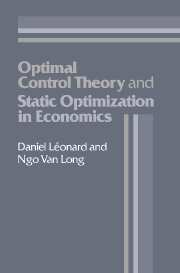Book contents
- Frontmatter
- Contents
- Preface
- 1 Static optimization
- 2 Ordinary differential equations
- 3 Introduction to dynamic optimization
- 4 The maximum principle
- 5 The calculus of variations and dynamic programming
- 6 The general constrained control problem
- 7 Endpoint constraints and transversality conditions
- 8 Discontinuities in the optimal controls
- 9 Infinite-horizon problems
- 10 Three special topics
- Bibliography
- Index
Preface
Published online by Cambridge University Press: 05 June 2012
- Frontmatter
- Contents
- Preface
- 1 Static optimization
- 2 Ordinary differential equations
- 3 Introduction to dynamic optimization
- 4 The maximum principle
- 5 The calculus of variations and dynamic programming
- 6 The general constrained control problem
- 7 Endpoint constraints and transversality conditions
- 8 Discontinuities in the optimal controls
- 9 Infinite-horizon problems
- 10 Three special topics
- Bibliography
- Index
Summary
As the range of problems tackled by economists expands, the curriculum of economics programs follows. Questions of choice in dynamic economic models are often an integral part of such programs. The most useful technique for dealing with these questions is optimal control theory. It was developed in the late 1950s as an outgrowth of the centuries-old calculus of variations, and it has been traditional to present an exposition of the latter as a preliminary to this more modern technique. Here we break with this tradition on the grounds that there is nothing to be learned from the calculus of variations that cannot be learned from optimal control theory, whereas the converse is not true. Our approach emphasizes the links between the methods of classical programming and those of optimal control theory. For this reason we begin with a thorough and lengthy exposition of static optimization techniques: unconstrained, equality-constrainted, and inequality-constrained problems (Chapter 1). After presenting some simple solution techniques for differential equations and their qualitative analysis through phase diagrams (Chapter 2), we proceed with a very short and informal chapter introducing various concepts related to optimization in dynamic models (Chapter 3). Chapter 4 describes the optimal control format for dynamic optimization problems and the core of its solution procedures, known as the maximum principle. We have attempted to make the reader's first encounter with a standard control problem as limpid as possible by relegating all complications to a later stage and emphasizing the links with the Lagrangean methods of static optimization.
Information
- Type
- Chapter
- Information
- Publisher: Cambridge University PressPrint publication year: 1992
